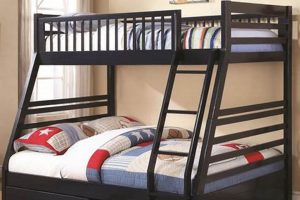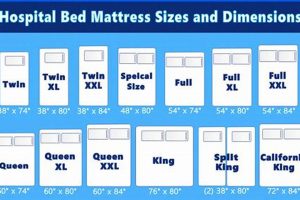A sleeping surface designed specifically for use on elevated sleeping structures is a key component of efficiently utilizing space, particularly in shared rooms or areas with limited square footage. These are commonly thinner than standard sleeping platforms to ensure safety and prevent exceeding the guardrail height on the upper bunk.
Proper support and comfort are essential for restorative sleep, regardless of the bed’s configuration. Selecting a suitable sleeping surface contributes to overall well-being by promoting healthy spinal alignment and pressure point relief. Historically, choices were limited, but contemporary manufacturing advancements have broadened the array of available options, accommodating varied preferences and budgetary constraints. The right one maximizes comfort and safety in elevated sleeping arrangements.
Subsequent sections will explore crucial factors in selecting appropriate dimensions, construction materials, and safety considerations for these specialized sleeping surfaces. Furthermore, it will delve into the benefits of different mattress types like memory foam, innerspring, and latex. These considerations will guide informed decision-making when choosing a suitable product for a bunk bed.
Selecting an Appropriate Sleeping Surface for Elevated Beds
Ensuring optimal comfort and safety requires careful consideration when selecting a sleeping surface for bunk structures. The following tips offer guidance for informed decision-making.
Tip 1: Prioritize Thickness. Mattress thickness is paramount to safety. Exceeding the manufacturer’s recommended height can compromise guardrail effectiveness. Measure the distance between the bed frame and the top of the guardrail before making a selection. Thinner profiles are typically necessary.
Tip 2: Evaluate Support Structure. Innerspring, foam, and hybrid constructions offer varying degrees of support. Consider the bed user’s weight and sleeping preferences when evaluating the internal structure. A firmer core generally provides greater spinal alignment.
Tip 3: Assess Material Composition. Consider the material composition of the sleeping surface with the bed user’s potential sensitivities in mind. Some foams, such as memory foam, may contain volatile organic compounds (VOCs). Opt for CertiPUR-US certified products to minimize exposure to potentially harmful chemicals.
Tip 4: Determine Appropriate Size. Match the sleeping surface dimensions precisely to the bunk frame. Gaps between the edge of the surface and the frame present a safety hazard. Confirm measurements prior to purchase.
Tip 5: Factor in Weight Capacity. Bunk beds have specific weight limitations. Ensure that the chosen sleeping surface, combined with the weight of the user, does not exceed the bed frame’s maximum weight capacity. Overloading can lead to structural failure.
Tip 6: Consider Fire Retardancy. Confirm that the sleeping surface meets fire safety standards. Fire-resistant materials enhance safety in the event of a fire. Look for products that comply with relevant regulations and safety certifications.
These considerations will aid in the selection of a suitable and safe sleeping solution for elevated beds. Prioritizing safety, support, and material composition will contribute to a more restful and secure sleep environment.
The subsequent section will cover common challenges associated with the product, offering guidance on preventing common mistakes and maximizing its benefits.
1. Thickness restrictions
Thickness restrictions are a primary consideration when selecting a sleeping surface for bunk structures, directly impacting safety and optimal space utilization. Exceeding stipulated dimensions can compromise the protective function of the guardrails and potentially lead to injuries.
- Guardrail Height Compliance
The most critical aspect of thickness restrictions is maintaining adequate guardrail height. Exceeding the recommended mattress height diminishes the effectiveness of the guardrail, increasing the risk of falls, particularly from the upper bunk. Many bunk beds have specific labeling indicating the maximum permissible thickness. For instance, a bunk bed might specify an 8-inch maximum; using a 10-inch mattress would reduce the guardrail’s protective height by two inches, a potentially significant safety compromise.
- Ladder Accessibility
Thickness also influences ladder accessibility. A significantly thicker sleeping surface can obstruct or reduce the usable height of the ladder rungs, making it difficult and potentially dangerous for the user to ascend or descend. This is especially relevant for younger children who may lack the coordination to navigate a significantly altered ladder configuration. Example: if a thick sleeping surface reduces the top rung’s clearance to a few inches, safe climbing may become difficult.
- Weight Distribution and Support Frame Stress
While thickness isn’t directly the primary driver of weight capacity exceeding recommended thickness often leads to an inappropriate sleeping surface selection that exceed the bed’s recommended weight. This excess weight puts additional stress on the bunk bed’s support frame. While properly constructed frames are robust, exceeding weight limits can contribute to accelerated wear, sagging, or, in extreme cases, structural failure. This is particularly relevant if the sleeping surface is substantially denser due to thicker, higher-density materials.
- Overall Room Space Optimization
Though secondary to safety, thickness plays a role in optimizing available room space. In smaller shared rooms, even a few inches of additional sleeping surface height can make the room feel more cramped. Thinner options contribute to a more streamlined aesthetic and maximize perceived space, aligning with the practical needs often driving the choice of a bunk configuration in the first place. Example: In a small dorm room, a lower-profile bunk bed with thinner sleeping surfaces creates a less imposing presence and frees up visual space.
Thickness restrictions are intrinsically linked to the overall safety and functionality of a bunk bed. While comfort remains a consideration, safety dictates careful adherence to prescribed thickness limits. The implications extend beyond immediate fall risk, affecting ladder accessibility, structural integrity, and even the perceived spaciousness of the room. Therefore, thickness should be a primary factor guiding the selection process.
2. Support requirements
Appropriate support characteristics are paramount when selecting a sleeping surface specifically designed for bunk structures. The configuration of bunk necessitates careful consideration of support attributes to ensure spinal alignment and prevent di
scomfort.
- Spinal Alignment and Posture Maintenance
A primary function of a mattress is maintaining proper spinal alignment throughout the sleep cycle. Bunk occupants, ranging from children to adults, require support systems that accommodate their individual weight distribution. Inadequate support can lead to spinal misalignment, resulting in back pain, muscle stiffness, and compromised sleep quality. For instance, a lightweight foam model may provide insufficient support for a heavier individual, causing spinal curvature and discomfort.
- Pressure Point Relief
Prolonged pressure on specific areas of the body during sleep can restrict circulation and cause discomfort. The mattress should effectively distribute weight to minimize pressure points, particularly around the shoulders, hips, and knees. Options incorporating memory foam or specialized zoning can offer enhanced pressure relief compared to traditional innerspring models. A surface that does not provide adequate pressure relief might lead to tossing and turning, disrupting sleep.
- Weight Distribution and Sag Prevention
Bunk bed sleeping surfaces are subject to concentrated weight loads, particularly in the center. A robust support system is essential to prevent sagging over time, which can compromise comfort and spinal alignment. Materials with high density and resilient construction, such as high-density foam or reinforced innerspring coils, contribute to long-term support and sag prevention. Premature sagging can create an uneven sleeping surface, exacerbating pressure points and spinal misalignment.
- Edge Support and Stability
Edge support is particularly important in bunk configurations. Strong edge support ensures stability when sitting on the edge of the mattress and maximizes the usable sleeping surface area. Weak edge support can create a feeling of instability, particularly for the occupant of the top bunk, and may increase the risk of rolling off the surface. Reinforced edges, often achieved through the incorporation of firmer foam or specialized coil systems, enhance edge support and overall stability.
The integration of these support elements is crucial for selecting a suitable sleeping surface. Disregarding support requirements can lead to discomfort, compromised sleep quality, and potential long-term health implications. Choosing a surface with appropriate support characteristics is integral to maximizing the benefits and safety of a bunk system.
3. Material safety
The composition of a sleeping surface for elevated sleeping platform demands rigorous evaluation due to prolonged exposure and the potential impact on respiratory health, especially within the often confined space of a shared bedroom. The inherent risks associated with volatile organic compounds (VOCs) and allergenic substances necessitate informed decision-making.
- Volatile Organic Compounds (VOCs) Emission
Many conventional mattress foams and adhesives release VOCs, such as formaldehyde, toluene, and benzene. Prolonged exposure to these compounds can trigger respiratory irritation, headaches, and allergic reactions, especially in sensitive individuals. Certifications like CertiPUR-US ensure that foam components meet strict emission standards, minimizing exposure to potentially harmful VOCs. Opting for materials with low or no VOC emissions directly mitigates these health risks, ensuring a safer sleep environment.
- Flame Retardants
While fire safety regulations often mandate the use of flame retardants in mattresses, certain chemical flame retardants have been linked to adverse health effects, including endocrine disruption and developmental problems. Researching the types of flame retardants used and opting for alternatives like silica or wool can reduce potential health risks. Some manufacturers offer products that meet fire safety standards without relying on potentially harmful chemicals.
- Allergenic Materials
Sleeping surfaces can harbor allergens, such as dust mites, mold, and pet dander, triggering allergic reactions in susceptible individuals. Selecting hypoallergenic materials, such as latex or tightly woven fabrics, can minimize allergen accumulation. Encasements specifically designed to block allergens provide an additional layer of protection. Regular cleaning and maintenance protocols are also crucial in mitigating allergen exposure.
- Heavy Metals and Phthalates
Some mattress components, particularly in lower-quality or imported products, may contain heavy metals like lead and cadmium or phthalates used as plasticizers. These substances can leach out over time and pose potential health risks, particularly for children. Verifying that the product adheres to relevant safety standards and regulations, such as those set by the Consumer Product Safety Commission (CPSC), is crucial in minimizing exposure to these harmful substances. Prioritizing products from reputable manufacturers with transparent sourcing practices further enhances safety.
The intersection of these elements highlights the critical role of material safety in selecting a suitable sleeping surface for elevated beds. Informed consumers must prioritize products with low emissions, safe flame retardants, hypoallergenic properties, and compliance with relevant safety standards to mitigate potential health risks and ensure a secure sleep environment, particularly within the confined setting of a bunk structure.
4. Size conformity
Accurate dimensional matching is a critical prerequisite when selecting a sleeping surface for bunk structures. The consequences of neglecting size conformity extend beyond mere aesthetic considerations, impacting safety, structural integrity, and user comfort.
- Prevention of Gaps and Entrapment Hazards
Dimensional precision minimizes the risk of gaps forming between the sleeping surface and the bunk frame. Gaps create potential entrapment hazards, particularly for children. Small limbs or clothing can become lodged in these spaces, leading to injury. Specifically, a sleeping surface that is too narrow or short for the frame presents significant risks. Conversely, a mattress that is too large will not fit safely within the frame.
- Optimization of Support and Weight Distribution
Proper sizing ensures that the sleeping surface rests correctly on the bunk’s support structure. A mattress that is too small may not receive adequate support, leading to uneven weight distribution and accelerated wear. This can compromise the structural integrity of the bunk frame and reduce the lifespan of the sleeping surface itself. Conversely, a mattress that is too large may strain the frame, potentially leading to damage.
- Enhancement of Sleep Quality and Comfort
Dimensional accuracy directly affects user comfort. A surface that is too small may feel restrictive, hindering movement and disrupting sleep. One that is oversized may overhang the frame, creating an unstable sleeping environment. Adhering to the recommended dimensions ensures a stable, comfortable, and safe sleep experience. Comfort is intimately tied to perceived safety and directly promotes longer, deeper rest.
- Compliance with Safety Regulations
Many regulatory
bodies and manufacturers stipulate specific dimensional requirements for sleeping surfaces used in bunk configurations. Compliance with these regulations ensures that the product meets minimum safety standards and reduces the risk of injury. Disregarding these standards may void warranties and expose the user to unnecessary hazards. These regulations exist to minimize the risk of death or serious injury.
Precise sizing for elevated sleeping surfaces represents a non-negotiable aspect of safety and functionality. It goes beyond simple fit. Adherence to established dimensional parameters is integral to maximizing the benefits of a bunk configuration while minimizing the inherent risks. Consequently, a rigorous measurement and selection process is crucial for ensuring a secure and comfortable sleep environment.
5. Weight limitations
Weight limitations are a critical safety parameter intrinsically linked to the selection and use of a sleeping surface on an elevated sleeping structure. The total weight, comprising the mattress and the occupant(s), must not exceed the bunk bed’s specified maximum weight capacity. Exceeding this limit can lead to structural stress, potential frame failure, and significant safety hazards. Consider a scenario where a bunk bed is rated for a maximum of 200 lbs per bunk. Utilizing a heavy innerspring mattress weighing 80 lbs and a user weighing 150 lbs would exceed this limit, creating a dangerous situation.
Manufacturers establish weight limits based on the structural design, materials used in construction, and anticipated use conditions. These limits are derived from rigorous testing designed to simulate real-world stress over extended periods. Ignoring these limits can compromise the integrity of the frame joints, support beams, and safety rails. Furthermore, exceeding the weight limitation negates any product liability on the manufacturer’s part. For example, if a child and an adult were both to occupy a bunk whose weight limit is 150lb, not only is it dangerous but if any accident occur, the manufacturers are not liable for damages.
Compliance with weight limitations is essential for safe use and to maintain the structural integrity of the bunk bed. Understanding these limits and selecting appropriately sized and weighted mattresses is vital. Adherence to weight specifications minimizes the risk of collapse, injury, and ensures the longevity of the bunk bed system. This understanding, combined with regular inspection for damage, forms the foundation of a safe bunk bed environment.
Frequently Asked Questions
This section addresses common inquiries regarding the selection, usage, and safety considerations of sleeping surfaces designed for elevated sleeping platforms.
Question 1: What are the primary safety considerations when selecting a sleeping surface for a bunk?
Thickness limitations are paramount. The sleeping surface must not exceed the manufacturer’s recommended height, as this compromises the guardrail’s protective function. Compliance with weight limitations is also critical to prevent structural failure.
Question 2: How does sleeping surface thickness affect bunk safety?
Excessive thickness reduces the effective height of the guardrail, increasing the risk of falls from the upper bunk. It also impacts ladder accessibility, potentially making it difficult and dangerous for occupants to climb in and out.
Question 3: What type of support structure is best suited for an elevated bed sleeping surface?
The ideal support structure depends on the user’s weight and sleeping preferences. Firmer support is generally recommended for spinal alignment, particularly for heavier individuals. Options include innerspring, foam, and hybrid constructions.
Question 4: What material considerations are crucial for bunk sleeping surfaces?
Volatile organic compound (VOC) emissions should be minimized. Opt for CertiPUR-US certified foams to reduce exposure to potentially harmful chemicals. Hypoallergenic materials are advisable to minimize allergen accumulation.
Question 5: Why is accurate sizing essential for sleeping surfaces in bunk applications?
Precise sizing prevents gaps between the surface and frame, minimizing entrapment hazards, especially for children. Proper sizing also ensures even weight distribution and optimizes support.
Question 6: What are the potential consequences of exceeding the weight limitation of a bunk?
Exceeding the specified weight limit can compromise the structural integrity of the bunk, leading to sagging, joint failure, and potentially catastrophic collapse. Adherence to weight specifications is non-negotiable.
Selecting an appropriate sleeping surface for an elevated bed requires careful attention to safety, support, material composition, and dimensional accuracy. Prioritizing these factors ensures a secure and restful sleep environment.
The next section will explore common misconceptions surrounding elevated bed sleeping surfaces, providing clarity and dispelling misinformation.
Conclusion
The preceding exploration underscores the critical considerations in selecting a `mattress for bunk bed`. Safety mandates adherence to thickness restrictions and weight limitations. Support requirements dictate the choice of materials and construction, ensuring spinal alignment and pressure relief. The implementation of size conformity is crucial to prevent entrapment hazards. Finally, attention to material safety ensures a healthy sleep environment.
Neglecting these multifaceted elements can lead to compromised safety, diminished sleep quality, and potential long-term health implications. The judicious selection of a `mattress for bunk bed`, founded upon informed decision-making, is paramount to safeguarding the well-being of the user and maximizing the functionality of the bunk system. Therefore, diligence and awareness must guide the selection process to ensure a secure and supportive sleep environment.


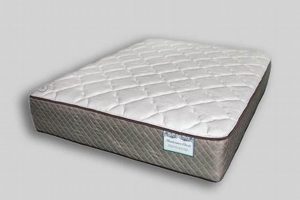
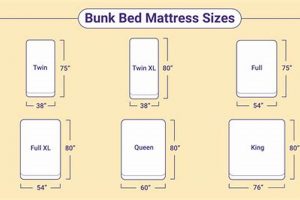
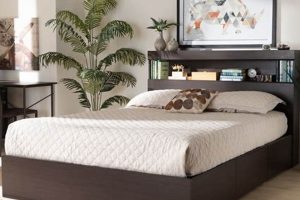
![Best Foldable Sofa Bed Mattress [Guide] For Your Bed! Organic & Natural Mattress Buyer’s Guide: Non-Toxic Sleep Solutions Best Foldable Sofa Bed Mattress [Guide] For Your Bed! | Organic & Natural Mattress Buyer’s Guide: Non-Toxic Sleep Solutions](https://mattressworldpa.com/wp-content/uploads/2025/07/th-7036-300x200.jpg)
